I've updated this very popular article a little bit and pushed it up from the archives, since it is the season for cold noodles now. I'll also have a followup recipe soon for the perfect accompaniment to zaru soba. Originally published in May 2007.
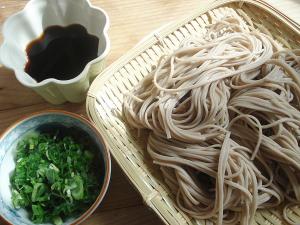
Most of Japan gets very hot and humid in the summer. To combat the heat, a number of dishes meant to be eaten cold have been developed. One of the main cold summer dishes is cold noodles.
Soba noodles, made of soba (buckwheat), are available all year round but are really popular when the heat turns unbearable. As with other cold noodles, they are prepared in a way that may seem strange if you're used to pasta and other Western-style noodles. Unlike pasta, most Japanese noodles, including soba, are rinsed rather vigorously in cold running water. This not only cools them down but gets rid of excess starch, which adversely affects the flavor of the noodles. Many recipes written in English omit this critical rinsing step: you don't just plunge it in cold water, as many directions incorrectly state, but you actively wash the noodles. Once you've done this once, you will definitely notice the difference. I've given detailed instructions for this procedure below.
Dipped into a properly made sauce or soba tsuyu, with plenty of spicy condiments or yakumi, there's nothing more refreshing to eat on a hot summer evening.
Filed under:
basics japanese summer noodles soba
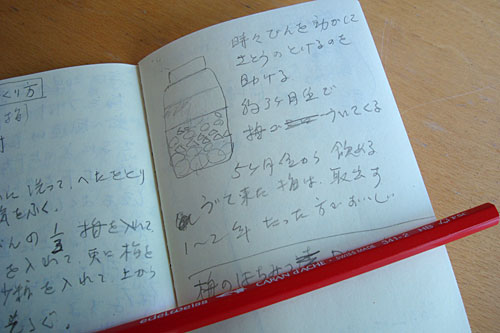
Since so many people liked my mom's umeboshi recipe, here are two more recipes using ume plums from her. She doesn't have photos for these, so I've taken a picture of her notes, with a little illustration she did of how to layer the ume and sugar for the umeshu (plum wine).
Filed under:
drink fruit japanese preserves and pickles summer mom's recipes
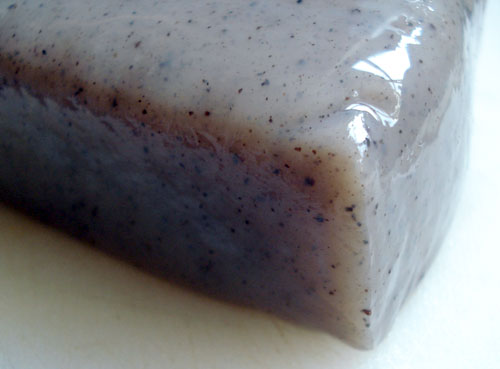
From the archives. For some reason I've been getting several email questions about konnyaku recently, so here is my definitive (I hope) guide to preparing konnyaku and konnyaku noodles, or shirataki. Originally published in January 2007.
The quintessential Japanese foods that (may) help you lose weight, are konnyaku and shirataki. Both are made from the same substance, the corm of the konnyaku or konjac plant. Shirataki is also known as konnyaku noodles, to further confuse things, but I prefer the original name which means "white waterfall". It's basically konnyaku shaped like long thin noodles.
Filed under:
japanese lighter weightloss diet ingredients low-carb

We still haven't found a house to buy (though we may getting close), and due to the way things work in France, we are probably going to be nomads for at least 4 more months even if we put in an offer for a place tomorrow. I've gotten more used to cooking in tiny holiday home kitchens, but I'm still not up to anything too complicated - or in other words anything that requires the use of more than 2 burners at a time.
Fortunately it's now summer, which means lighter, less complicated meals anyway. This salad, which can be a meal on its own, a starter or a light side dish, features sweet salad onions (spring is the season for them, at least around these parts), sliced paper-thin and refreshed in ice cold water. The tart dressing features umeboshi (pickled plums) and uses no oil, so this is an almost fat-free, fairly low calorie dish, that's vegan to boot.
Filed under:
japanese lighter vegetarian summer noodles vegan salad soba

It seems that quite a few people have been trying out the kasutera/castella recipe recently, and running into problems. Castella is not an easy cake. So, since it's Easter, I thought I'd haul this out of the archives attic. These little 'rich tea cakes' are much easier to make, and while they have an entirely different texture they are really quite delicious. I hope you'll give them a try! The fondant is not too hard if you can get a hold of the glycerin, but alternatively you could use store bought Easter themed cake decorations. Originally published in March 2005, as part of the late lamented Is My Blog Burning food blog event.
Filed under:
food events party food imbb spring baking easter cupcakes bunny
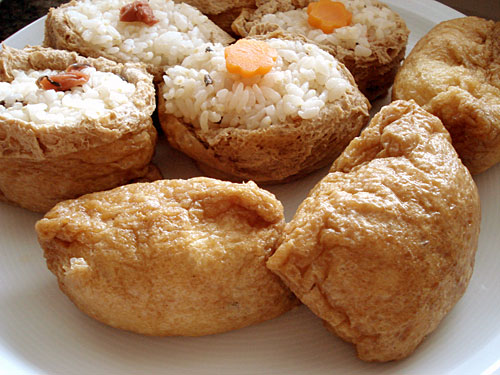
Four years ago I posted a very basic recipe for inarizushi, homely sushi that is stuffed into a fried tofu skin or aburaage. It's been one of the most popular articles here on Just Hungry ever since. That only gave instructions for stuffing pre-made (canned or vacuum packed) skins, so I thought I'd update it with instructions for making your own inarizushi skins from scratch. These instructions will be particularly useful to vegetarians and vegans, since most if not all premade skins are cooked in a fish-based traditional dashi stock. And, for all of you who have had problems making Eggs in Treasure Bags with those small, thin canned skins: You'll find that making the eggs from your own, sturdy skins is so much easier.
Filed under:
japanese vegetarian sushi favorites vegan washoku
From the archives, originally posted March 2, 2007. These delicately colored sushi are a great way to use __usuyaki tamago__. I know I've been re-posting things from the archives a lot lately, but I hope you'll forgive me - I'm moving tomorrow! In any case, I hope you'll give these delicate sushi a try, especially if you have daughters or granddaughters.
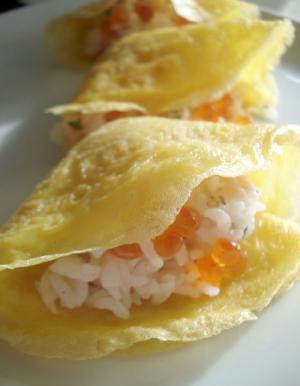
The 3rd of March is Momo no sekku or Peach Day in Japan. Peach blossoms usually start blooming around this time, signifying the coming of spring. It's also the day for _hina matsuri_, the Doll Festival or Girls' Festival. Households with daughters display hina ningyou-, traditional dolls that represent a princess's wedding procession. This is because the ultimate happiness expected for a girl was for her to make a fruitful and comfortable marriage. Nowadays girls may be expected to do other things besides become happy wives, but on this day at least traditions still hold strong.
In Japan there is a long standing stereotype that girls and women like very sweet things, while manly men like less sweet and bitter things. So, for Hina Matsuri the guests are served sweet things like amazake (a very thick non-alcoholic hot drink made from the lees of sake, rather like eggnog in color and cloying sweetness), hishimochi (tri-colored mochi cake) and okoshi (colored sweetened puffed rice). Although there were three girls in our house, none of us liked amazake at all. However, my mother often made some kind of sushi for Hina Matsuri, which we really loved.
Here are two kinds of very pretty, girlie sushi in feminine pink, yellow and white with a touch of green. These colors fit the theme of Hina Matsuri perfectly: the traditional hishimochi is colored white, pink (or light red) and green.
Filed under:
eggs japanese party food spring rice sushi bento
Submitted by maki on 17 February, 2009 - 20:40
Update: I've updated this post substantially in these two articles, 10 years later: How to cook great Japanese style rice, and How to make sushi rice (shari). Please take a look there - you'll probably find them a lot clearer. I've learned a lot myself in 10 years! ^_^
This is the first how-to and recipe that I posted on Just Hungry. Properly cooked rice is the foundation of a traditional Japanese meal, and you absolutely cannot skimp on the steps detailed here if you are aiming for anything approaching authenticity. I've edited the text to make some things clearer. Back to basics! Originally published in November 2003.
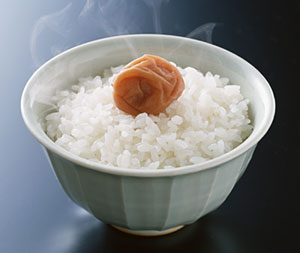
Rice is the staple of Japanese food, and making it just right can be rather difficult if you don't know how. If you think you will be preparing rice regularly, an electric rice cooker will make your life so much easier. You can cook non-Japanese style rice in it too, though I tend to make those in a regular pan.
Type:
recipe Filed under:
basics japanese rice sushi favorites
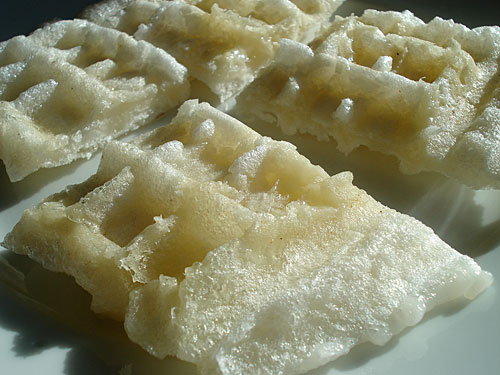
How to make moffles or mochi waffles, a relatively new but very popular snack in Japan, in a regular waffle maker.
Filed under:
japanese snack rice quickcook offbeat gluten-free mochi
Pages